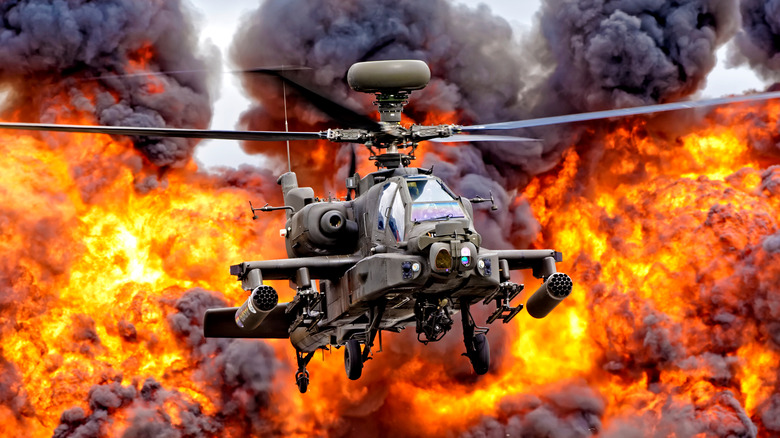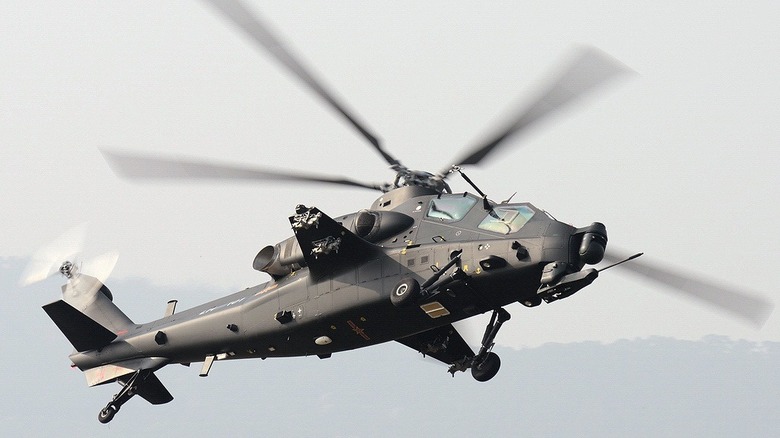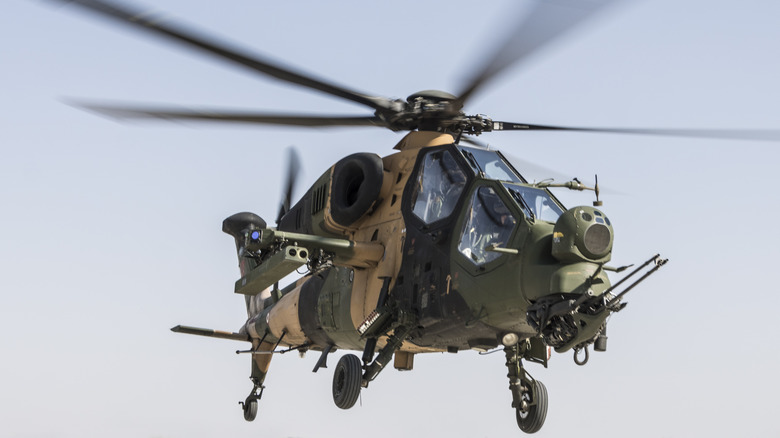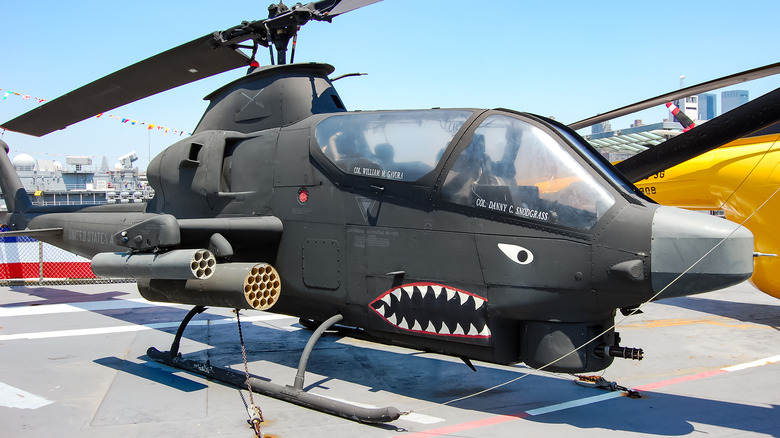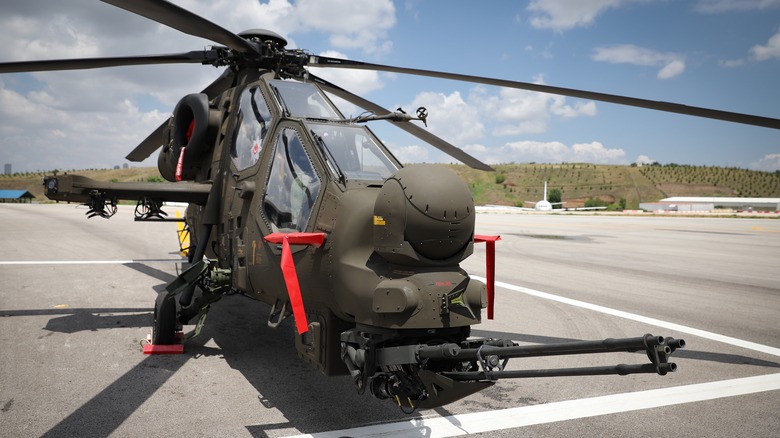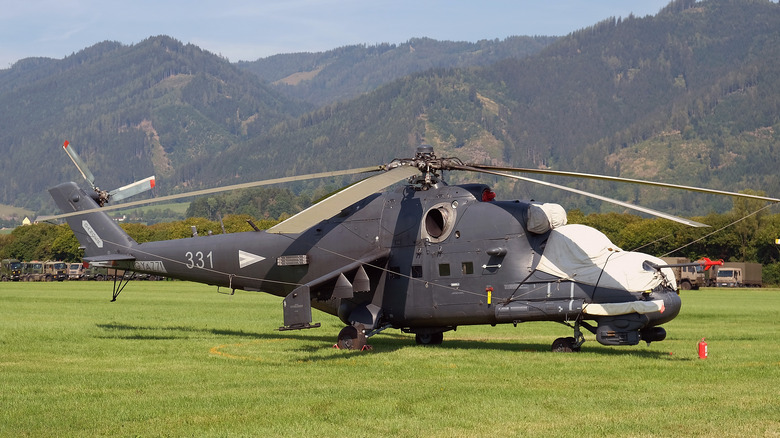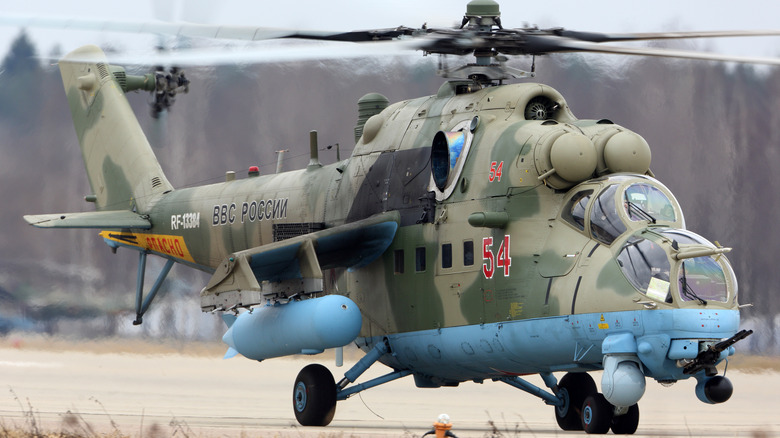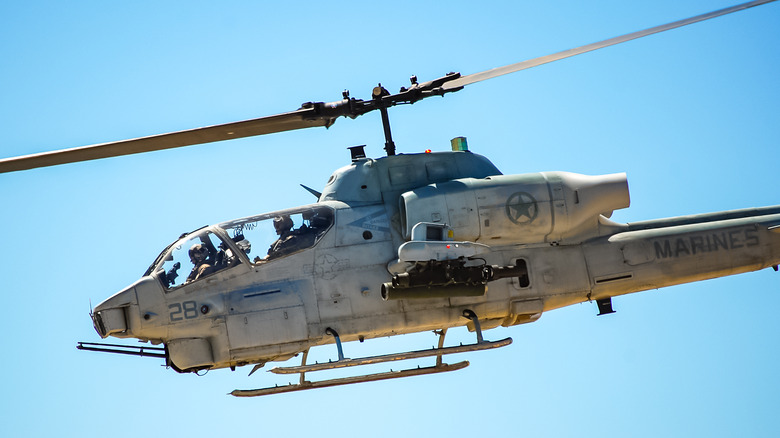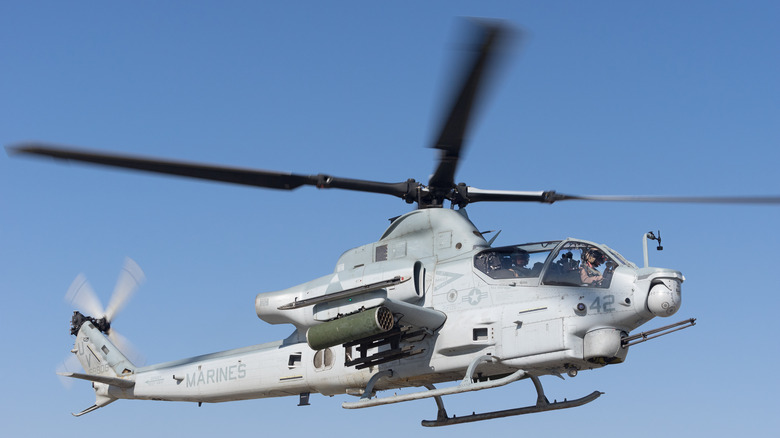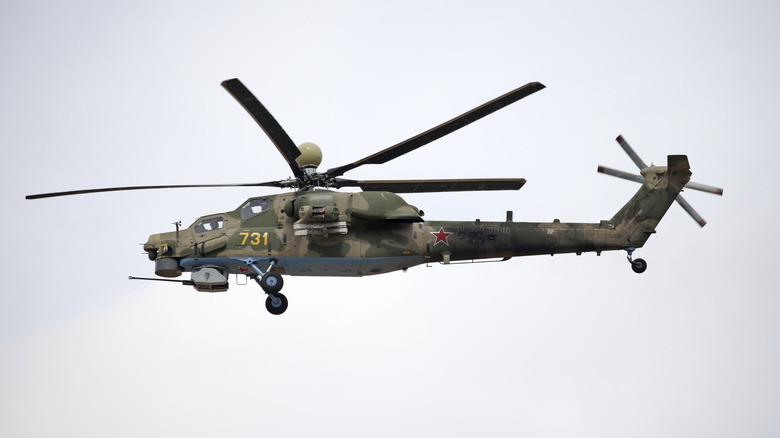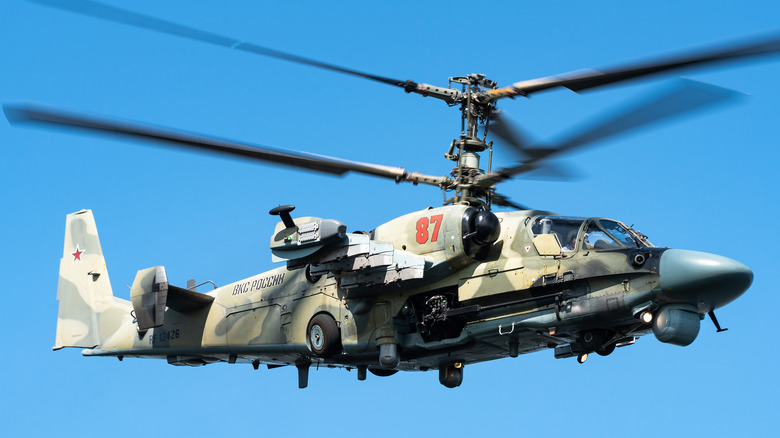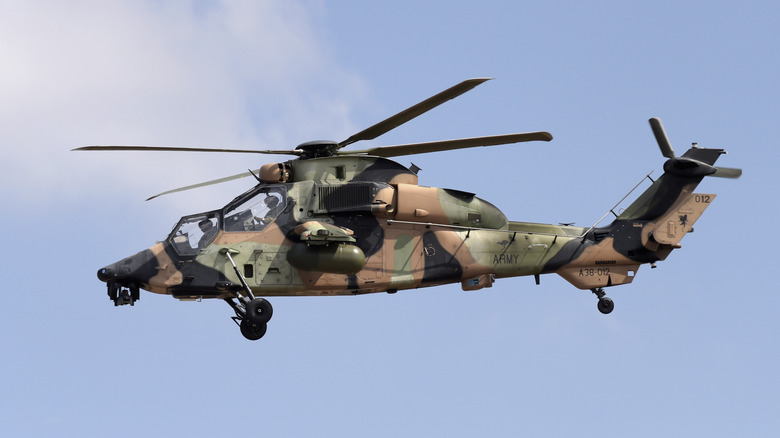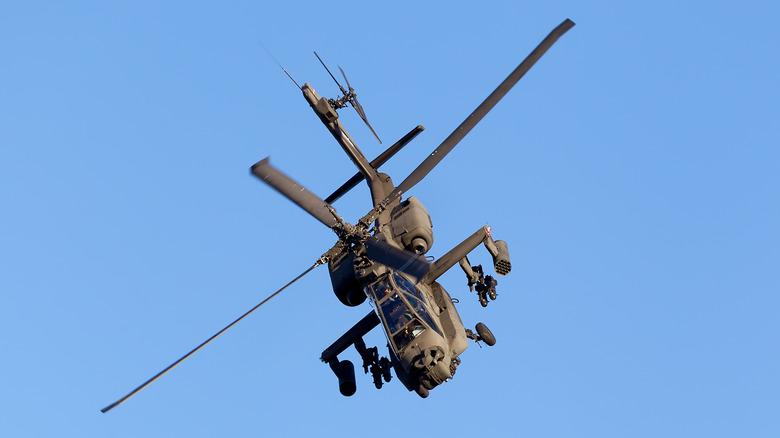The Top 12 Best Attack Helicopters Ever Used In War, Ranked
Attack helicopters have become a staple of modern warfare and are emblazoned on the public consciousness through appearances in many Hollywood blockbusters, military documentaries, and newsreels. They have played an essential role in several recent conflicts, from the Gulf War and Operation Desert Storm to the War on Terror, having first cut their teeth in the Korean and Vietnam wars. These early engagements demonstrated the versatility of these agile, accurate machines for providing close air support to troops and providing anti-tank and anti-armor capabilities.
During World War II, it was noted that smaller, slower aircraft could hit targets with greater accuracy, leading to the conversion of light fixed-wing models like the Piper Cub, which became the L-3 Grasshopper as a bazooka-equipped surveillance plane. This idea was expanded with the development of the helicopter in the 1950s. These were soon to be given limited combat capabilities and, by the 1960s, had matured into the full-blown attack helicopters that we know today, starting with the American Bell AH-1 and Russian Mil Mi-24.
The intervening years have seen significant developments for the attack helicopter. By ranking these, it is easy to trace the evolution of these extraordinary machines and the advancement in their capabilities. The following attack helicopters have made the most significant impact when used in warfare, and are ranked according to their specifications, performance, armament, and operational history.
Changhe Z-10
The Changhe Z-10 is China's first native attack helicopter, designed for anti-armor and close air support missions as the People's Liberation Army's answer to America's AH-1 Cobra. However, compared to its U.S. counterpart, it is much larger, heavier, and less agile. It has about 50% of the Cobra's firepower, making it a statistically poor adversary despite being produced around 40 years later. At 7,500 kilograms, it is even considerably heavier than its contemporaries, the Eurocopter Tiger and A129 Mangusta, and China failed to meet the weight requirements for the Changhe Z-10 to be a consideration for use by E.U. nation militaries.
Despite its shortcomings, the Changhe Z-10 incorporates modern avionics and weaponry, boosting its reputation on the world stage. These include helmet-mounted optics, radar warning systems, ejector seats, stealth properties, and advanced GPS navigation. Its armament consists of a 23-millimeter machine gun, rockets, and missiles, with a payload of up to 1,500 kilograms when fully loaded.
While China is currently embroiled in conflict and tension along its borders, the Changhe Z-10 has seen limited action, and given its lesser capabilities compared to its peers, it ranks the lowest on this list.
[Featured image by Shimin Gu via Wikimedia Commons | Cropped and scaled | GFDL 1.2]
T129 ATAK
The T129 ATAK is a Turkish attack helicopter developed with Italian and Turkish collaboration and built by AgustaWestland. It is a dual-seat, twin-engine, multi-role model that performs attack, armed reconnaissance, and precision strike missions. It is built over a lightweight aluminum alloy frame and designed to operate in all weather scenarios while excelling in hot conditions. As a result, this versatile helicopter has attracted interest from countries in Asia and the Middle East.
Where the T129 ATAK differs from its older Mangusta sibling is its modern features. It incorporates the latest night-flying instruments and thermal-imaging cameras and has up-to-date avionics, including a helmet-mounted display and advanced targeting systems. Its armament is also cutting-edge, with an array of up to 76 rockets, laser-guided air-to-ground missiles, long-range anti-tank missiles, a 500-round 20mm cannon, and Stinger air-to-air missiles.
The Turkish, Pakistani, and Philippine militaries currently use the T129 ATAK. However, it has yet to prove itself in a major conflict, with one unit being shot down in 2018 over Afrin in Syria while supporting the Free Syrian Army. As such, it is one of our lowest-ranking choices.
Bell AH-1 Cobra
Few helicopters have had such a storied history as the Bell AH-1 Cobra. It was the world's first dedicated attack helicopter, created for use by the U.S. Marine Corps, which played a crucial role during the Vietnam War (which became known as the "Helicopter War"). It spawned many variants for different applications, with additional training seats, four and five rotors, retractable skids, and different armament configurations. Upgrades of the original Cobra, like the twin-engine AH-1Z Viper, remain in service following its successful run.
As a result of the large-scale destruction of helicopters at the start of the Vietnam War, a requirement was identified for a heavily armed unit that was still agile and quick. The AH-1 Cobra went into production after that and was in full production by June 1967. Weighing 14,750 pounds, it could fly at an altitude of over 11,000 feet, reached speeds of 175 miles per hour, and had a relatively long range of 375 miles.
Throughout the war, the Bell AH-1 Cobra flew countless sorties in support of ground troops and provided air support to troop-carrying helicopters, such as the ubiquitous Bell UH-1 "Huey." It went on to serve in conflicts in Panama, Grenada, and, later, the Gulf War. While the original "Snake" left a significant impression on history as a stalwart of U.S. fighting forces, it has been succeeded by upgraded variants, leaving it lower in this ranking.
A129 Mangusta
The aptly named Mangusta translates from Italian as "Mongoose," and like the wily snake-killing mammal, this attack helicopter has considerable ability to strike and decimate its foe. As the first attack helicopter to be wholly designed and manufactured in Europe, the Italian aircraft continues to be built by AgustaWestland almost 50 years after its conception.
One of the most notable claims of the A129 Mangusta is that it was the first helicopter to use a computer management system. This feature made it considerably easier to operate. It has since become standard equipment on modern helicopters across all segments. With a pilot and a gunner for crew, it has an armament of up to eight Hellfire missiles, rockets, air-to-air Stinger missiles, and cannons, and has advanced night-vision functionality.
The A129 Mangusta offers anti-armor and close air support capabilities and has seen service with NATO in Somalia, Afghanistan, and Iraq. It is still used primarily by Italy and Turkey. While it is undeniably effective at its roles, it is getting a little long in the tooth and is outclassed by some of its peers, including the Eurocopter Tiger and Boeing Apache.
Mil Mi-24
In the mid-1960s, at around the same time as the development of the AH-1 Cobra, the Soviet Union was already planning its own attack helicopter to rival that of the United States. This was dubbed the Mi-24 (later given the NATO code of "Hind") and was a rugged and heavily armed unit which, unlike its U.S. counterpart, had a troop-carrying capacity.
Having first been put to use during the 1977 Ogaden conflict between Somalia and neighboring Ethiopia, the Mi-24 was deployed to Afghanistan, where it proved highly useful in the Soviet-Afghan war of 1979. Here, it provided essential support to ground troops who could not easily navigate the harsh Afghan terrain and to extricate rebel forces who had gone to ground in the impenetrable hills, using its cannon, missiles, rockets, and bombs.
The Mi-24 has since seen action in numerous conflicts, including those in Iraq and Afghanistan, and has been continuously upgraded by Russia with more modern variants. However, various militaries, including Russia, still use the original, which operates alongside its more modern iterations.
Mil Mi-35
The Russian Mi-35 Hind is a modernized version of the Mi-24 which continues to serve in various countries, combining troop transport and attack capabilities. It offers much-improved maneuverability and overall performance compared to its predecessor. Its high-precision weapons provide superior ground support with the ability to identify and destroy targets, perform MEDEVAC duties, and ferry troops to and from combat zones.
A pilot and gunner crew the Mi-35, and it can carry up to eight troops for deployment. Its maximum payload is 2,400 kilograms and it boasts advanced avionics, including night-vision capabilities and satellite-guided navigation. Its armament comprises a 23-millimeter cannon and optional wing-mounted rockets, missiles, and additional guns.
Following the collapse of the Soviet Union, several Mi-35 Hind helicopters were commandeered by the Indian Air Force. These were soon to see action in Sierra Leone as part of Operation Khukri and later in repelling rebel attacks in Congo. It is also operated by the armies of Russia, Kazakhstan, Nigeria, and Pakistan.
Bell AH-1W Super Cobra
As a United States Marine Corps upgrade of the AH-1 Cobra, the AH-1W Super Cobra has been a reliable asset in multiple conflicts, including the Gulf War, the humanitarian intervention in Somalia, the invasion of Iraq, and the war in Afghanistan. It was launched in 1986 and became known for its anti-ship capabilities, provision of close air-ground support to troops in firefights, and ground attack coordination.
The Super Cobra was the first attack helicopter that incorporated Sidearm anti-radiation missiles and Sidewinder air-to-air missiles, each with a range of 15 kilometers, making it a formidable fighting force in its day. As recently as 2003, as the War on Terror raged in Iraq, multiple Super Cobras, or "snakes," as they were called, were tasked with providing air support to Marines on the ground in and around Baghdad and assisting British forces in Basra, in the south.
Ultimately, Super Cobra squadrons headed to Tikrit, the hometown of Saddam Hussein, where they were instrumental in bringing an end to the war after flying thousands of combat sorties. This was yet another chapter in the long and storied history of the AH-1W Super Cobra before it was retired in 2020 and replaced by the Bell AH-1Z Viper.
Bell AH-1Z Viper
With the AH-1W Super Cobra's honorable retirement imminent, the Bell company was tasked with the development of a worthy successor, and the result was the AH-1Z Viper. As an upgraded version of the United States' successful attack helicopter, the AH-1Z boasts advanced sensors and weaponry, making it a formidable machine that meets the demands of modern militaries.
The AH-1Z Viper provides air-to-ground fire support, aerial surveillance, and escort duties for troops on the ground, making this a versatile jack-of-all-trades. It features integrated avionics with helmet-mounted displays. It incorporates the latest weapons systems, including Sidewinder air-to-air missiles and system-guided rockets, with long-range, all-weather sensors for identifying targets. It is made safer than its predecessor with the addition of armored seats, self-sealing fuel tanks, and an advanced missile and radar warning system, and its crew can fully control it from the front or rear seat.
The Bell AH-1Z Viper has already been deployed in several conflicts, including missions in Iraq and Afghanistan. It has proved highly effective in supporting ground troops, thanks mainly to its versatility and maneuverability, and has attracted the interest of many foreign nations, making the AH-1Z an already successful enterprise for the Bell company.
Mil Mi-28 Havoc
The Cold War was a fruitful time for military production, and significant financial reserves were set aside by the United States and the Soviet Union to develop new aircraft and weaponry. Work began on a new Soviet attack helicopter in 1980 but was shelved soon after in favor of the light-combat Kamov Ka-50. It wasn't until almost 30 years later that the program was resumed, and the modernized Mi-28 Havoc rolled off the production line in 2008.
After a long wait, Russia's Mi-28 turned out to be a formidable attack helicopter designed for anti-armor and close air support missions. It features advanced armor protection and weaponry, including its distinctive chin-mounted turret with a 30-millimeter cannon that boasts a maximum firing range of 4,000 meters and a rate of fire of up to 800 rounds per minute. The Mi-28 is also powerful, with two Russian-built 2,200-horsepower engines to lift its 11,500 kilograms (fully laden).
The Mi-28 Havoc most recently went into combat over Ukraine, where its numbers have been significantly depleted, often because their anti-tank missiles require them to hover, exposing them to the air defenses of the Ukrainian forces.
Kamov Ka-50/52 Hokum
The Kamov Ka-50 series of helicopters (with the NATO designation of "Hokum") are among the most sinister attack helicopters, born during the Cold War when deception was an essential component of military strategy. After a long development period, it entered service in the mid-1990s in a limited capacity, as Russia was still financially reeling from the collapse of the Soviet Union.
The Ka-50 (single-seat) and Ka-52 (two-seat) are among the most advanced Russian attack helicopters ever created, featuring exceptional maneuverability and modern avionics. They are designed for anti-armor and anti-helicopter roles and took cues from the United States Apache, with which it shares several similarities in its technology and armament. Unlike the Apache, they have twin coaxial rotors, which eliminate the need for a tail rotor and provide excellent handling, unaffected by strong winds, as well as quieter operation.
Before creating the dual-seat Ka-52 variant, the Russians, somewhat amusingly, tried to fool the competition by painting a second cockpit on the fuselage of the Ka-50. However, the genuine article was soon realized and proved to be a great success, as both machines went on to serve in the Chechnyan conflict. Here, they effectively eliminated groups of Chechen rebels who were dug in at high altitudes. As the most advanced helicopters in Russia's extensive catalog, the Hokum variants rank among the highest on this list.
Eurocopter Tiger
Less than ten years after Airbus produced the impressive Eurofighter Typhoon fighter jet, the company manufactured its sibling attack helicopter, the Eurocopter Tiger, as another collaborative effort between France and Germany. It is designed for high-intensity conflicts as a multi-role unit with advanced anti-tank and air-to-air capabilities. It is equally proficient at performing various combat roles in day and nighttime conditions.
The Eurocopter Tiger is crewed by two personnel and, like with the Bell AH-1Z Viper, the pilot and gunner can switch roles. Each has access to complete flight data via detailed displays, some of which are mirrored on their helmet visors, giving operatives an immersive flying experience and complete control of weapons and systems. These include bespoke avionics, such as its EUROGRID battle management software and detailed digital maps.
Such advanced technology has been put to use in various conflicts, and the Eurocopter Tiger has seen action in Mali, the Central African Republic, Libya, and Afghanistan. It remains Europe's most advanced attack helicopter that is surpassed only by the best effort of the United States.
Boeing AH-64 Apache
The AH-64 Apache is arguably the most iconic attack helicopter in the world. It is known for its firepower, agility, and advanced avionics and has been used extensively in various conflicts, including the Gulf War and, more recently, in Iraq and Afghanistan. Manufactured for the U.S. military, the Apache is its primary heavy-division attack helicopter. It is effective at reconnaissance, engaging moving targets, and deep precision strikes in day, night, and adverse-weather conditions.
The Apache's fearsome armament consists of fire-and-forget Hellfire missiles, Hydra air-to-ground rockets, and Stinger missiles. These are made more effective by its superior avionics, which increases its lethality, improves survivability, and creates better situational awareness through its helmet-mounted display. This also allows the gunner to visualize the target, and the main 30-millimeter chain gun tracks their head movement and aims where they look, making targeting an extension of the gunner's vision.
The Boeing AH-64 Apache has achieved a lot in the almost fifty years since it made its first flight. It has become a legend among its peers as a machine that consistently outperforms the competition, and it has been regularly upgraded to meet the latest military requirements and integrate state-of-the-art technology. As such, the Apache makes the top of this ranking, as it continues to improve while remaining true to its tried and trusted architecture, and it looks like it will be around for many years to come.
